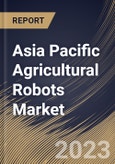The market for agricultural robots is driven by many agricultural technology companies developing, experimenting with, and launching various robotic systems designed for various agricultural purposes. Future growth of the market is expected to be increased by factors such as rising population, rising demand for food, growing popularity of indoor farming, frequent climate variations, and surge in automation use of technology. The adoption of telematics sensors represents a prospective market opportunity on a regional scale.
The demand for agricultural robots is expected to rise due to rising automation technology adoption, growing food, and feed demand, increasing popularity of indoor farming, and unpredictability of the weather. Population growth in urban and urban areas is the primary driver of economic development. A rise in demand for food production results from this scenario. The agriculture sector increasingly uses agricultural robots to fulfill the fast-rising food demand and prevent food shortages. Indoor farming is gaining popularity due to its capacity to increase local food supplies and provide consumers with fresh produce.
Agricultural robots in the Asia Pacific region are deployed for various applications, including planting, weeding, harvesting, spraying, monitoring, and livestock management. Precision agriculture practices are gaining traction in the Asia Pacific region. Asia Pacific countries are increasingly focused on sustainability and reducing the environmental impact of agriculture. The adoption of agricultural robots in the Asia Pacific region is a part of the global trend of digitalization and automation in agriculture. As technology continues to advance and farmers seek more efficient, sustainable, and data-driven farming practices, the adoption of agricultural robots is expected to continue growing, playing a pivotal role in the future of agriculture in the region.
The China market dominated the Asia Pacific Agricultural Robots Market, by Country in 2022, and would continue to be a dominant market till 2030; thereby, achieving a market value of $3,743.9 Million by 2030. The Japan market is exhibiting a CAGR of 20% during (2023 - 2030). Additionally, The India market would experience a CAGR of 21.8% during (2023 - 2030).
Based on Type, the market is segmented into Dairy Robots, Driverless Tractors, UAVs, and Material Management. Based on Application, the market is segmented into Milking, Harvest Management, Livestock Monitoring, Spraying Management, Planting & Seeding Management, Monitoring & Surveillance, and Others. Based on Offering, the market is segmented into Hardware, Software, and Services. Based on countries, the market is segmented into China, Japan, India, South Korea, Australia, Malaysia, and Rest of Asia Pacific.
The market research report covers the analysis of key stake holders of the market. Key companies profiled in the report include AGCO Corporation, Autonomous Solutions, Inc., Lely International N.V., CNH Industrial N.V., CLAAS KGaA mbH, GEA Group AG, Harvest Automation, Inc., Trimble, Inc., Agrobot and DeLaval.
Scope of the Study
Market Segments Covered in the Report:
By Type- Dairy Robots
- Driverless Tractors
- UAVs
- Material Management
- Milking
- Harvest Management
- Livestock Monitoring
- Spraying Management
- Planting & Seeding Management
- Monitoring & Surveillance
- Others
- Hardware
- Software
- Services
- China
- Japan
- India
- South Korea
- Australia
- Malaysia
- Rest of Asia Pacific
Key Market Players
List of Companies Profiled in the Report:
- AGCO Corporation
- Autonomous Solutions, Inc.
- Lely International N.V.
- CNH Industrial N.V.
- CLAAS KGaA mbH
- GEA Group AG
- Harvest Automation, Inc.
- Trimble, Inc.
- Agrobot
- DeLaval
Unique Offerings
- Exhaustive coverage
- The highest number of Market tables and figures
- Subscription-based model available
- Guaranteed best price
- Assured post sales research support with 10% customization free
Table of Contents
Companies Mentioned
- AGCO Corporation
- Autonomous Solutions, Inc.
- Lely International N.V.
- CNH Industrial N.V.
- CLAAS KGaA mbH
- GEA Group AG
- Harvest Automation, Inc.
- Trimble, Inc.
- Agrobot
- DeLaval








